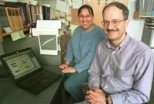In a discovery that may someday help lengthen human life spans, an MIT researcher reported in the March 8 issue of Nature that he has helped roundworms live up to 50 percent longer.
It has long been known that significantly cutting calorie intake increases life span in a variety of organisms. Professor of Biology Leonard P. Guarente is zeroing in on this phenomenon, which appears to be a survival mechanism.
Professor Guarente studies the silenced information regulator (SIR2) gene and its apparent ability to slow the aging process. His research team has shown that in yeast, an enzyme co-factor and the SIR2 gene, responsible for making the Sir2 protein, join forces with a reduction in calories to slow down aging.
In this experiment on Caenorhabditis elegans, or the ordinary roundworm, Professor Guarente inserted extra copies of chromosomes into larvae.
"Lo and behold, the worms with the extra section containing the SIR2 gene lived extraordinarily long," he said. "We conclude that, as in yeast, increasing the dosage of an SIR2 gene extends life span," wrote Professor Guarente and his co-author, postdoctoral associate Heidi A. Tissenbaum.
Professor Guarente is convinced that molecular tinkering can affect the aging process in all organisms. This latest work also supports the theory that SIR2 is tied to metabolism and aging. An SIR2-like gene seems to extend life span by affecting the organism's insulin-signaling pathway. "If you reduce signaling in that pathway, you make the worm live longer," he said. "Our findings suggest that Sir2 proteins may couple longevity to nutrient availability in a wide variety of organisms."
Restricting calorie intake in yeast leads to an increase in the activity of the Sir2 protein (made by the SIR2 gene) required for genomic silencing. When part of the organism's genetic material is silenced, or turned off, it prevents one particular cause of death in older yeast cells.
In these cells, a circular piece of the cell's genetic material, in the process of recombining to form new proteins, sometimes pinches off from a chromosome. These superfluous coils accumulate in the cell, causing it to enlarge and eventually die. By silencing sections of the genome, the Sir2 protein seems to reduce this phenomenon.
Professor Guarente is seeking a genetic manipulation that would increase the activity of Sir2 protein without resorting to caloric restriction. C. elegans has four genes similar to the yeast SIR2 gene. In the study, worms that were given an increased dosage of sir-2.1, the gene most similar to SIR2, lived up to 50 percent longer than their ordinary counterparts. (Worms usually live around two weeks; the one who received an extra copy of sir-2.1 lived up to three weeks.) The effect seemed tied to the creatures' insulin-signaling pathway.
In worms, the insulin-signaling pathway comes into play when organisms are threatened with starvation. If the larvae are in an environment where a lack of food threatens their ability to survive, they may become what is known as "dauers," in which they enter a dormant stage where they can survive for months.
If a worm already is an adult, becoming a dauer is impossible. The next best thing is making the adult worm live longer in the hope that if conditions improve, it will be able to reproduce.
"What's true in yeast and worms is probably generally true in all organisms, because these organisms are so divergent," Professor Guarente said. "We had every reason to think this wouldn't work, but it does."
These findings also are remarkable because while yeast cells divide until they die, worm cells don't divide once they are mature -- just as the cells in some of our organs, such as the heart and brain, do not regenerate.
"It seems remarkable that aging in yeast and aging in adult worms are both regulated by Sir2 proteins," he said. "It will be interesting to determine whether Sir2 proteins regulate the rate of aging in still higher eukaryotes, which contain both dividing and post-mitotic cells."
Professor Guarente's next step is to try the experiment on mice.
This work is supported by the National Institutes of Health, the Ellison Medical Foundation, and the Linda and Howard Stern Fund.
A version of this article appeared in MIT Tech Talk on March 14, 2001.






